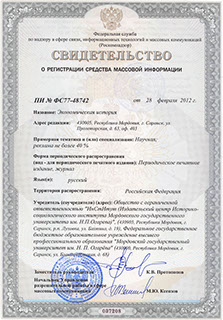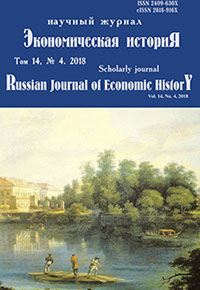Экономическая историЯ
Russian Journal of Economic History
ISSN 2409-630X (Print)
ISSN 2618-916X (Online)
Expert board:
- Scientific Council of RAS on economic history;
- Research and Educational Center «The economic history of Central Russia and the Middle Volga region» of Ogarev Mordovia State University;
- Center of Economic History of Lomonosov Moscow State University
Navigation
Certificate of registration

ISSN 2409-630X (Print), ISSN 2618-916X (Online)
DOI: 10.15507/2409-630X.043.014.201804.404-413
УДК 94(470) «19»:271
Eugene N. Efremov
Mordovian State Pedagogical Institute named after M. E. Evseviev (Saransk, Russia),
e-mail: een.pravo@gmail.com
ECONOMIC POLICY OF THE CHUVASH AUTHORITIES TO REVIVE THE RUSSIAN ORTHODOX CHURCH IN THE LATE 1980s – EARLY 2000s
Introduction. The turn of the 1980s-1990s in the history of our country is characterized by the liberalization of the social system, which changed, in particular, the relations between the state and the Orthdox church. One of the crucial issues in this area is the consideration of state support for the revival of the Church, which allows to determine the place and role of the Orthodox confession in the life of post-Soviet Russia. The article analyzes the features of the historical development of the economic policy of regional authorities aimed at restoring the position of the local eparchy, which was implemented in the late 1980s – early first decade of the 2000s.The purpose of the research is to reveal a comprehensive chronological framework of the historical aspects of economic policy carried out in relation to the Orthodox confession of Chuvashia. Materials and Methods. To achieve this goal, both unpublished archival documents and published sources were used. The main source for the article was the materials from the funds of the state historical archive of the Chuvash Republic and the state archive of modern history of the Chuvash Republic (documents of official records management of public authorities and religious organizations), which are first introduced into scientific use. The study is based on the principle of historicism, comparative-historical and descriptive methods, which revealed the content of the research. Results. According to the results of the study of economic policy of the Chuvash authorities to revive The Cheboksary-Chuvash eparchy in the late 1980s–early 2000s, the author gives a comprehensive description of the considered historical processes. In particular, two stages concerning the transformation of state support for Orthodoxy are proposed and described. The first phase covers 1987–1993 and it is connected with the origin and formation of the practice of returning the monuments of Orthodox Church culture to the Cheboksary-Chuvash eparchy, periodic financial assistance for their repair and restoration work. The second stage (1993–2003) is the time of approval and implementation of the conceptual bases of restoration of the property confiscated from the Russian Orthodox Church during the Soviet period of history, fixed in the regional legislation. It is also established that the main directions of economic policy of the Chuvash authorities in relation to the Russian Orthodox Church were the return of the Church from the state jurisdiction of the property confiscated from it during the Soviet era, as well as the allocation of funds and construction materials for the repair of destroyed and the construction of new churches. Discussion and Conclusion. The consideration of the amount of economic assistance provided by the leadership of the Chuvash Republic to the local Orthodox Church testify to their important role in the full revival of Orthodoxy to the beginning of the first decade of the 2000s, which began in the Chuvash Republic in 1987. The process of state revival of the Church until 1993 was not systematic and was carried out as the need for ongoing democratic reforms. Only in 1994–1997 the decrees of the President of the Chuvash Republic were adopted, accelerating not only the free transfer of buildings-monuments of Orthodox architecture to the ownership of the Cheboksary-Chuvash eparchy, but providing significant financial support for its revival. Undoubtedly, by assisting The Cheboksary-Chuvash eparchy in the restoration of Orthodox architecture, the local authorities fulfilled their moral duty to make amends for the crimes committed by the Soviet state against the Orthodox Church in the Republic.
Keywords: denominations, Russian Orthodox Church, Chuvash ASSR Orthodoxy, Chuvash Republic, Cheboksary-Chuvash diocese.
For citation: Eugene N. Efremov. Economic Policy of the Chuvash Authorities to Revive the Russian Orthodox Church in the late 1980s – early 2000s. Ekonomicheskaya istoriya = Russian Journal of Economic History. 2018; 14(4): 404–413. (In Russ.). DOI: 10.15507/2409-630X.043.014.201804.404-413
© Ogarev Mordovia State University. History and Sociology Institute, 2017
68, Of. 411, Bolshevistskaya St., 430005, The editorial office of the scholarly journal «Russian Journal of Economic History»
Tel.: (8342) 24-25-90; 27-07-11, Fax: (8342) 24-25-90, E-mail: jurnal-econom-hist@isi.mrsu.ru
Designed by A. Napalkov, Email: napalkov@isi.mrsu.ru

